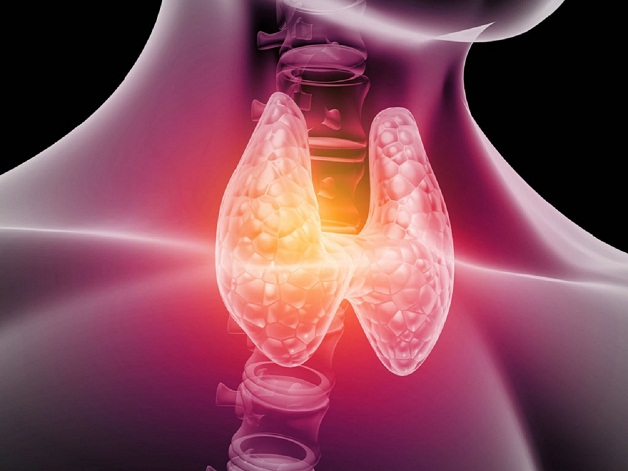Thyroid cysts are a common health issue, particularly prevalent in women, with a higher incidence compared to men. This often prompts many to inquire about the risks associated with thyroid cysts and effective treatment methods. Below, we provide crucial information on thyroid cysts and common treatment approaches in a medical writing style.
1. What is a Thyroid Cysts?
A thyroid cystic nodule is a prevalent occurrence affecting many individuals within their thyroid gland system. It manifests as an abnormal growth in a specific region of the thyroid gland tissue. Here are important details to understand about thyroid cysts.

Thyroid cysts are fluid-filled nodules within the thyroid. Pure thyroid cysts are usually benign
2. Symptoms of Thyroid Cystic Nodules
While thyroid cysts often remain asymptomatic, larger nodules can impact one’s health and comfort. The following are common symptoms associated with larger thyroid cystic nodules:
2.1. Difficulty swallowing and throat discomfort
Patients may experience difficulty or pain while swallowing food or liquid due to the increased pressure on the neck caused by the enlarged thyroid nodule.
2.2. Hoarseness, throat pain, and neck discomfort
Speech may be affected, leading to throat and neck pain as the pressure from the thyroid nodule compresses or irritates surrounding structures, causing difficulty in speaking and discomfort.
2.3. Perception of a lump under the skin in the neck region
Upon palpation of the neck area, a noticeable lump may be felt due to the enlarged size and expansion of the thyroid nodule, altering the neck’s overall appearance.
2.4. Aesthetic concerns
When the thyroid cystic nodule becomes visible externally, it can affect one’s appearance and diminish self-confidence. This is attributed to the large size and position of the nodule altering the overall shape of the neck.

Thyroid cyst often causes discomfort concentrated in the neck area
2.5. Managing these symptoms
Regular ultrasound examinations aid in monitoring the thyroid nodule’s growth and assessing symptoms. Monitoring changes through periodic examinations helps physicians determine necessary interventions. In cases where a large thyroid cystic nodule significantly impacts health, the doctor may recommend specific treatment based on the individual case.
While large thyroid cystic nodules may cause considerable inconvenience, regular monitoring and guidance from a physician help manage symptoms effectively, ensuring overall health.
3. Is Thyroid Cystic Nodule Dangerous?
Although thyroid cysts are generally benign, if not managed early, they can pose significant risks and impact the patient’s health. The cancer rates for various types of nodules are as follows:
– Simple cysts: Primarily fluid-filled, with a low cancer rate (0.3%).
– Mixed nodules: Comprising fluid and solid components, with an increased cancer rate (approximately 1.5%).
– Rapidly growing nodules: Rare cases may involve bleeding, causing neck pain and swallowing difficulties.
If the thyroid cystic nodule does not cause significant inconvenience and shows no signs of cancer, regular monitoring and controlling growth may suffice. In some cases, thyroid hormone therapy may help control growth and alleviate symptoms. Surgical removal may be recommended for large and severely impacting thyroid cystic nodules.
4. Diagnosing Thyroid Cysts
Diagnosing thyroid cystic nodules requires a combination of methods to provide an accurate assessment. The two primary diagnostic methods are as follows:
4.1. Ultrasound
Ultrasound is a common and effective diagnostic method. Physicians use ultrasound machines to create detailed images of the thyroid nodule. Ultrasound images offer information about the nodule’s composition, size, location, and notable features. This assists physicians in providing recommendations and selecting appropriate treatment methods.

Ultrasound is used in diagnosing thyroid disease
4.2. Fine-Needle Aspiration (FNA) Biopsy
Description: If ultrasound images raise suspicions, the physician may decide to perform an FNA biopsy.
Procedure: Using ultrasound guidance, a small needle is inserted into the thyroid nodule to collect cell samples.
Cell analysis: Cells collected are analyzed under a microscope to identify any abnormalities, particularly signs of cancer.
The combination of ultrasound and FNA biopsy provides accurate diagnosis and guides decisions on treatment methods. This process not only aids in early detection of potential issues but also ensures the safety and effectiveness of healthcare.
5. Treating Thyroid Cystic Nodules
Following ultrasound results, the decision on treatment modalities depends on factors such as nodule size, characteristics, and the patient’s overall health. Below are modern and effective treatment methods for thyroid cysts:
5.1. Small Thyroid Cysts
If the thyroid cystic nodule is small and asymptomatic, the physician may opt for regular monitoring through ultrasound without immediate treatment.
5.2. Large Thyroid Cysts
Surgical methods: In cases of large thyroid cysts causing compression on neighboring organs, traditional surgical removal may be considered.
Ethanol injection therapy: For simple cysts or nodules with minimal solid components, injecting ethanol into the nodule may be a safe and effective option.
Radiofrequency ablation (RFA) for thyroid nodules: This method employs high-frequency alternating current to generate heat, destroying the thyroid nodule. It offers high aesthetic value and leaves no visible scars.
By employing these methods, treating thyroid cysts not only yield high effectiveness but also ensure safety and aesthetic considerations during the healthcare process.








